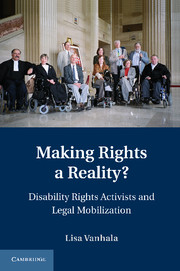Book contents
- Frontmatter
- Contents
- List of Figure and Tables
- Acknowledgments
- Abbreviations
- 1 Introduction: Legal Mobilization and Accommodating Social Movements
- 2 Rights and Political Identity in the Canadian Disability Movement
- 3 Disability Equality and Opportunity in the Supreme Court of Canada
- 4 Disability Organizations and the Diffusion of Rights in the United Kingdom
- 5 Framing Disability Equality in the UK Courts
- 6 Conclusions: Litigation, Mobilization, and Social Movements
- Bibliography
- Index
1 - Introduction: Legal Mobilization and Accommodating Social Movements
Published online by Cambridge University Press: 03 May 2011
- Frontmatter
- Contents
- List of Figure and Tables
- Acknowledgments
- Abbreviations
- 1 Introduction: Legal Mobilization and Accommodating Social Movements
- 2 Rights and Political Identity in the Canadian Disability Movement
- 3 Disability Equality and Opportunity in the Supreme Court of Canada
- 4 Disability Organizations and the Diffusion of Rights in the United Kingdom
- 5 Framing Disability Equality in the UK Courts
- 6 Conclusions: Litigation, Mobilization, and Social Movements
- Bibliography
- Index
Summary
THROUGH THE COURTROOM DOORS
In November 1979, Canadians with disabilities met in Ottawa to lobby the federal government on the issue of accessible transport, which, they argued, was crucial to achieving equality and social inclusion. Paradoxically, many activists, who had traveled from across Canada, encountered numerous barriers en route to Ottawa because of the difficulty of finding suitable modes of transport. Some attendees resorted to traveling in freight trains because their personal wheelchairs could not be accommodated in the passenger service cars. The struggle did not stop there. Upon their arrival in Ottawa, they discovered that the inaccessibility of the House of Commons made it impossible for some advocates to carry out meetings with Members of Parliament (MPs). In the late 1970s, such experiences of segregation were common for persons with disabilities. However, the incident was not all bad for the activists meeting in Ottawa; they effectively harnessed their stories to garner media support for their campaign and to stir debate within the political establishment. The government could no longer ignore the voice of Canadians with disabilities.
Almost thirty years later, the Supreme Court of Canada delivered its judgment in Council of Canadians with Disabilities v. VIA Rail Canada Inc., in favor of the Council of Canadians with Disabilities (CCD). At the heart of this case was the decision made by VIA Rail in late 2000 to purchase 139 rail cars (“Renaissance cars”) at a significant discount.
- Type
- Chapter
- Information
- Making Rights a Reality?Disability Rights Activists and Legal Mobilization, pp. 1 - 47Publisher: Cambridge University PressPrint publication year: 2010



